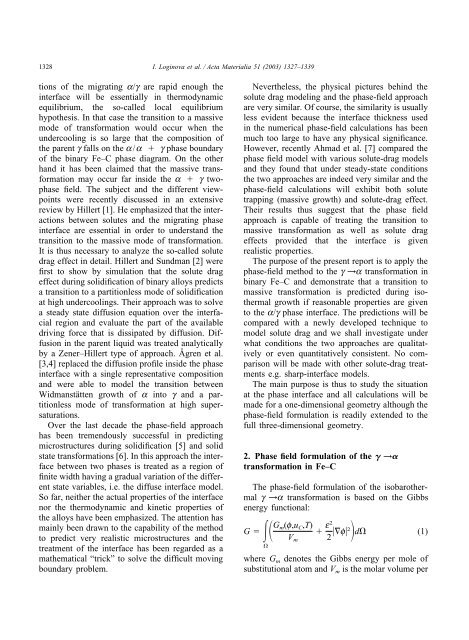Phase-field modeling of diffusion controlled phase ... - KTH Mechanics
Phase-field modeling of diffusion controlled phase ... - KTH Mechanics
Phase-field modeling of diffusion controlled phase ... - KTH Mechanics
Create successful ePaper yourself
Turn your PDF publications into a flip-book with our unique Google optimized e-Paper software.
1328 I. Loginova et al. / Acta Materialia 51 (2003) 1327–1339tions <strong>of</strong> the migrating a/g are rapid enough theinterface will be essentially in thermodynamicequilibrium, the so-called local equilibriumhypothesis. In that case the transition to a massivemode <strong>of</strong> transformation would occur when theundercooling is so large that the composition <strong>of</strong>the parent g falls on the a/a g <strong>phase</strong> boundary<strong>of</strong> the binary Fe–C <strong>phase</strong> diagram. On the otherhand it has been claimed that the massive transformationmay occur far inside the a g two<strong>phase</strong><strong>field</strong>. The subject and the different viewpointswere recently discussed in an extensivereview by Hillert [1]. He emphasized that the interactionsbetween solutes and the migrating <strong>phase</strong>interface are essential in order to understand thetransition to the massive mode <strong>of</strong> transformation.It is thus necessary to analyze the so-called solutedrag effect in detail. Hillert and Sundman [2] werefirst to show by simulation that the solute drageffect during solidification <strong>of</strong> binary alloys predictsa transition to a partitionless mode <strong>of</strong> solidificationat high undercoolings. Their approach was to solvea steady state <strong>diffusion</strong> equation over the interfacialregion and evaluate the part <strong>of</strong> the availabledriving force that is dissipated by <strong>diffusion</strong>. Diffusionin the parent liquid was treated analyticallyby a Zener–Hillert type <strong>of</strong> approach. Ågren et al.[3,4] replaced the <strong>diffusion</strong> pr<strong>of</strong>ile inside the <strong>phase</strong>interface with a single representative compositionand were able to model the transition betweenWidmanstätten growth <strong>of</strong> a into g and a partitionlessmode <strong>of</strong> transformation at high supersaturations.Over the last decade the <strong>phase</strong>-<strong>field</strong> approachhas been tremendously successful in predictingmicrostructures during solidification [5] and solidstate transformations [6]. In this approach the interfacebetween two <strong>phase</strong>s is treated as a region <strong>of</strong>finite width having a gradual variation <strong>of</strong> the differentstate variables, i.e. the diffuse interface model.So far, neither the actual properties <strong>of</strong> the interfacenor the thermodynamic and kinetic properties <strong>of</strong>the alloys have been emphasized. The attention hasmainly been drawn to the capability <strong>of</strong> the methodto predict very realistic microstructures and thetreatment <strong>of</strong> the interface has been regarded as amathematical “trick” to solve the difficult movingboundary problem.Nevertheless, the physical pictures behind thesolute drag <strong>modeling</strong> and the <strong>phase</strong>-<strong>field</strong> approachare very similar. Of course, the similarity is usuallyless evident because the interface thickness usedin the numerical <strong>phase</strong>-<strong>field</strong> calculations has beenmuch too large to have any physical significance.However, recently Ahmad et al. [7] compared the<strong>phase</strong> <strong>field</strong> model with various solute-drag modelsand they found that under steady-state conditionsthe two approaches are indeed very similar and the<strong>phase</strong>-<strong>field</strong> calculations will exhibit both solutetrapping (massive growth) and solute-drag effect.Their results thus suggest that the <strong>phase</strong> <strong>field</strong>approach is capable <strong>of</strong> treating the transition tomassive transformation as well as solute drageffects provided that the interface is givenrealistic properties.The purpose <strong>of</strong> the present report is to apply the<strong>phase</strong>-<strong>field</strong> method to the g →a transformation inbinary Fe–C and demonstrate that a transition tomassive transformation is predicted during isothermalgrowth if reasonable properties are givento the a/g <strong>phase</strong> interface. The predictions will becompared with a newly developed technique tomodel solute drag and we shall investigate underwhat conditions the two approaches are qualitativelyor even quantitatively consistent. No comparisonwill be made with other solute-drag treatmentse.g. sharp-interface models.The main purpose is thus to study the situationat the <strong>phase</strong> interface and all calculations will bemade for a one-dimensional geometry although the<strong>phase</strong>-<strong>field</strong> formulation is readily extended to thefull three-dimensional geometry.2. <strong>Phase</strong> <strong>field</strong> formulation <strong>of</strong> the g →atransformation in Fe–CThe <strong>phase</strong>-<strong>field</strong> formulation <strong>of</strong> the isobarothermalg →a transformation is based on the Gibbsenergy functional:G G m(f,u C ,T) e2V m 2 f2d (1)where G m denotes the Gibbs energy per mole <strong>of</strong>substitutional atom and V m is the molar volume per
















